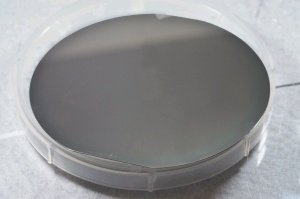Feb 18 2009
Diamond-like carbon films created at Sandia National Laboratories are helping probe the far boundaries of the solar system as part of a NASA mission to study how the sun's solar wind interacts with the interstellar medium - the matter that exists between the stars within a galaxy.
 Thirty Sandia films are in the low-energy sensor (IBEX-Lo) on board NASA’s Interstellar Boundary Explorer (IBEX), which lifted off in October on a mission to study the farthest fringes of the solar system. (Photo by Randy Montoya)
Thirty Sandia films are in the low-energy sensor (IBEX-Lo) on board NASA’s Interstellar Boundary Explorer (IBEX), which lifted off in October on a mission to study the farthest fringes of the solar system. (Photo by Randy Montoya)
The films are in the low-energy sensor (IBEX-Lo) on board NASA’s Interstellar Boundary Explorer (IBEX), which lifted off in October on a mission to study the farthest fringes of the solar system. IBEX’s two bucket-sized sensors, covering high and low energy ranges, are designed to capture particles bouncing back toward Earth from the distant boundary between the hot wind from the sun and the cold wall of interstellar space.
The active conversion surface of the low-energy neutral atom detector is coated with Sandia’s diamond-like films created by Tom Friedmann.
“The primary purpose of the diamond-like carbon films is to provide a surface that will ‘efficiently’ ionize energetic neutral atoms,” Friedmann says, “so they can then be detected. Smooth surfaces are required so that the scattered particles can be efficiently collected. If the surface is rough, scattered particles are lost, decreasing efficiency. The diamond-like carbon films have an average surface roughness that is about one angstrom. This is less than the diameter of a carbon atom.”
To create the 30 films aboard the system, Friedmann used pulsed-laser deposition to deposit the films on the conversion surfaces. Carbon was used because it has relatively high conversion efficiency, low sputter yield, and is very smooth, he says. Single crystal diamond has the highest efficiency but is too expensive to grow over large areas and difficult to polish to the extremely low surface roughness needed. The diamond-like carbon films naturally grow smooth and require no polishing.
Friedmann says the project took about one and a half months to complete and he says he was pleased with the outcome. Now the IBEX team is awaiting the results from the mission.
Eric Hertzberg, from Lockheed Martin Advanced Technology Center, approached Friedmann to create the films. Hertzberg is the lead engineer for the IBEX-Lo Sensor. Bob Nemanich, Arizona State University, also played a key role in passivating the films. Friedmann says Sandia uses similar films in studies of electron field emission and in microelectromechanical Systems (MEMS) devices.
Voyager 1, launched in 1977, made the first direct measurements of this boundary (the heliopause) as it was the first spacecraft to leave the inner solar system and head toward interstellar space. Voyager 2, launched the same year, will also relay observations of the boundary, but these measurements are of only one place and time.
IBEX is designed to provide a three-dimensional map of the boundary. IBEX is the latest in NASA’s series of low-cost, rapidly developed Small Explorers spacecraft. The IBEX mission was developed by Southwest Research Institute, led by Principal Investigator David McComas, with a national and international team of partners. NASA’s Goddard Space Flight Center manages the Explorers Program for NASA’s Science Mission Directorate.